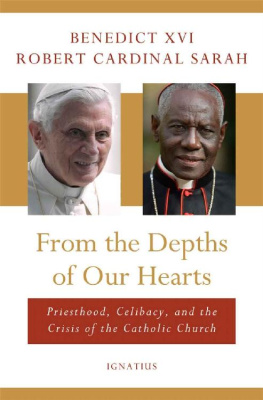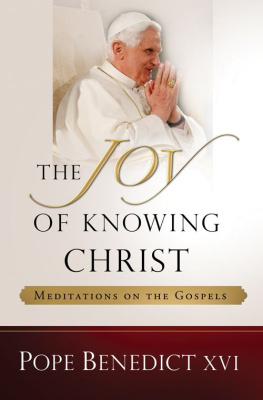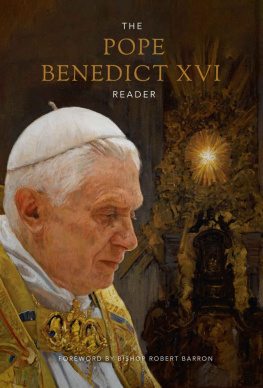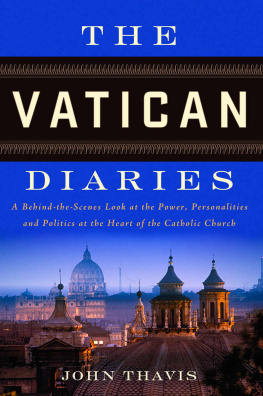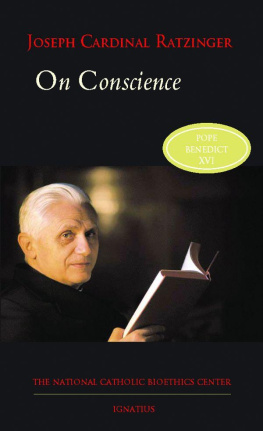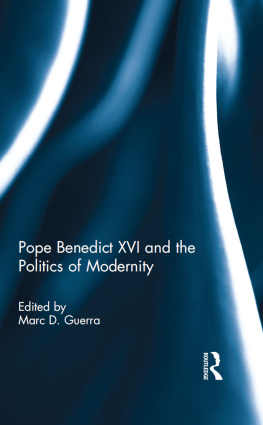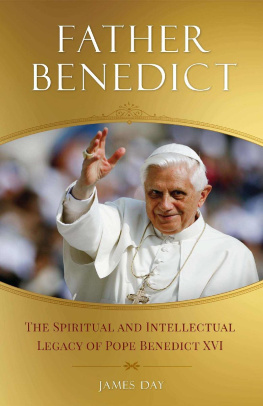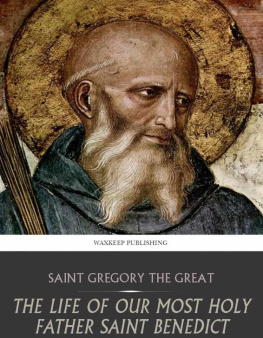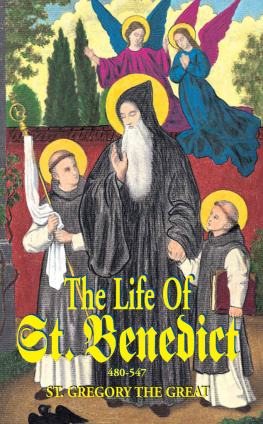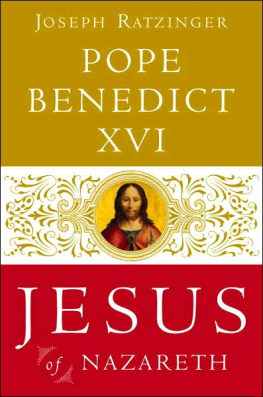Pope Benedict XVI - I Believe in One God: The Creed Explained
Here you can read online Pope Benedict XVI - I Believe in One God: The Creed Explained full text of the book (entire story) in english for free. Download pdf and epub, get meaning, cover and reviews about this ebook. year: 0, genre: Religion. Description of the work, (preface) as well as reviews are available. Best literature library LitArk.com created for fans of good reading and offers a wide selection of genres:
Romance novel
Science fiction
Adventure
Detective
Science
History
Home and family
Prose
Art
Politics
Computer
Non-fiction
Religion
Business
Children
Humor
Choose a favorite category and find really read worthwhile books. Enjoy immersion in the world of imagination, feel the emotions of the characters or learn something new for yourself, make an fascinating discovery.

- Book:I Believe in One God: The Creed Explained
- Author:
- Genre:
- Year:0
- Rating:5 / 5
- Favourites:Add to favourites
- Your mark:
- 100
- 1
- 2
- 3
- 4
- 5
I Believe in One God: The Creed Explained: summary, description and annotation
We offer to read an annotation, description, summary or preface (depends on what the author of the book "I Believe in One God: The Creed Explained" wrote himself). If you haven't found the necessary information about the book — write in the comments, we will try to find it.
I Believe in One God: The Creed Explained — read online for free the complete book (whole text) full work
Below is the text of the book, divided by pages. System saving the place of the last page read, allows you to conveniently read the book "I Believe in One God: The Creed Explained" online for free, without having to search again every time where you left off. Put a bookmark, and you can go to the page where you finished reading at any time.
Font size:
Interval:
Bookmark:
I BELIEVE IN ONE GOD
Visit our web site at
www.albahouse.org
(for orders www.stpauls.us)
or call 1-800-343-2522 (ALBA)
and request current catalog

Cover design: DX Imaging
Set by ST PAULS
Produced and designed in the United States of America by the
Fathers and Brothers of the Society of St. Paul,
2187 Victory Boulevard, Staten Island, New York 10314-6603
as part of their communications apostolate.
ISBN-10: 0-8189-1350-9
ISBN-13: 978-0-8189-1350-1
2012 Libreria Editrice Vaticana
00 120 Citta del Vaticano
www.libreriaeditricevaticana.com
2012 Edizioni San Paolo s.r.l.
Piazza Soncino, 5 - 20092 Cinisello Balsamo (Milano)
www.edizionisanpaolo.it
English language edition 2012 ST PAULS-UK
ST PAULS Publishing
187 Battersea Bridge Road, London SW11 3AS, UK
www.stpaulspublishing.com
North American Edition 2012 by the Society of St. Paul
2187 Victory Blvd., Staten Island, NY 10314-6603, USA
www.stpauls.us
Printing Information:
Current Printing - first digit 1 2 3 4 5 6 7 8 9 10
Year of Current Printing - first year shown
2013 2014 2015 2016 2017 2018 2019 2020 2021 2022
CONTENTS
by Timothy Michael Cardinal Dolan
by Giuliano Vigini
The Year of Faith announced by our Holy Father, Pope Benedict XVI, is a genuine gift to the Church as we observe and celebrate the fiftieth anniversary of the opening the Second Vatican Council and the twentieth anniversary of the publication of the Catechism of theCatholic Church. Catholics the world over will take this opportunity to renew and revitalize their own faith.
The new book, I Believe in One God, from ST PAULS is a welcome resource for anyone who is seeking to understand and live out his or her faith more deeply. The basics of our faith, those essential elements of what we believe and hold true, are explored and examined by Pope Benedict himself as he delves into the key components of the Nicene and Apostles Creed. I Believe in One God offers a fresh look at the three persons of the Holy Trinity, the Church, the sacraments, the Blessed Mother, and eternal life.
This inspiring text will also lead us to be more effective proponents of the NewEvangelization called for by Blessed Pope John Paul II, and so enthusiastically carried forward by Pope Benedict. We are all called to be joyful ambassadors of the reality of the Risen Lord in todays world, and to lead others to Jesus. However, there is the old Latin saying: Nemo dat quod non habet you cannot give what you do not have. It is impossible to really share the beauty, the mystery, the liberating nature of faith unless it is truly a part of us. This marvelous book will help anyone to be a more credible and joyful evangelizer.
I thank the editors at ST PAULS for bringing the Holy Fathers words to a broad audience, and I pray that I Believe in One God will be a much used and most treasured resource for the Year of Faith and many years to come.
+ Timothy Michael Cardinal Dolan
Archbishop of New York
In the Year of Faith the Church will be committed in a special way to reviving and deepening the knowledge of Catholic doctrine. A faith which is dull and dormant tarnishes and deforms the real meaning and authentic content of its everlasting value. One of the main aims of Pope Benedict, as he invites us to pass through the door of the faith, is to help everyone to learn the faith once more so as to live it with an increased awareness and maturity.
In the Pastoral Note of the Congregation for the Doctrine of the Faith there is a clear indication of the various events that will celebrate the Year of Faith. It is a time to re-evangelise believers so that they can evangelise and proclaim to others the Christ met in faith. The Note tells us that this is an ideal time for a more attentive reception of the homilies, catechesis, addresses, and documents of the Holy Father, through which we are guided to live the Creed we profess.
To have faith in God is the starting point. One of the tragedies of modern society is the lack of recognition, the loss, or the exclusion of the supremacy of God. The first article of the Creed, on the contrary, puts it as the beginning of everything. It is the source of all the truths about man, who receives from God meaning and direction for his life. It offers him the great hope of the life to come. All that exists in the universe has its origin in Him and returns to Him. Man is not an accidental product of evolution, but the living sign of the power and majesty of God, the free and rational fruit of the Word that was in the beginning. Whoever lives without knowledge of, or orientation towards, God cuts himself off from the source of life.
God has made Himself visible and comes close through the Love that is His very essence, as John tells us (1 Jn 4:8-16) and as the title of the first Encyclical of Benedict XVI, Deus caritas est proclaims. The Christian image of God and the consequent image of man are not simply theological and philosophical speculations. God manifested Himself and acted in Jesus Christ, His only begotten Son. He incarnated the truth of the Father and revealed Gods love for us. Thereby being the guiding star in the life of men, to lead them to the truth about themselves.
To seek God in the human face of Christ is to seek the truth about God. This truth has its origin in love and leads us to love others. In Benedict XVIs theology of faith, truth and love are always united: one finds its strength in the other and together they are the key to the mystery of creation, to the story of salvation and the mission of the Church. This is the heart of his message and of the Creed also. As the Holy Father has said, God, Christ and Love form a harmonious circle. Each is found in the other. The Logos of Truth opens and joins the minds of men in the Logos of Love, and this is the very essence of the Christian faith. The more we grow in the Truth of God, the more we remain in His love.
God enters the story of humanity as a baby, sharing with men their life situation but without sin. True God and true man, Jesus announces the Kingdom of God and calls everyone to repent so as to enable them to come under His Reign. At the end of His mission the plan of salvation is fulfilled by Jesus passion, death and resurrection, which are the core of the Creed. The Cross symbol of suffering and love, forgiveness and reconciliation becomes the new rainbow of God that joins heaven to earth; it drives away the darkness of night and looks forward to the dawn of Easter.
The cross and resurrection are the moment when the earthly life of Christ reaches its climax. They are not only the central and crucial truth of the faith, but also the beginning of a new era in history. Raised forever from the underworld, Jesus returns as a living person to encounter men. The apostles and first disciples spread the proclamation of this extraordinary event: the tomb is empty and Jesus appears to his people. When he goes up to heaven they do not feel lonely and abandoned. Benedict XVI notices, in his second volume of Jesus of Nazareth, they are now confident that the Risen One is lifted up at the right hand of the Father and will always be with them in a new way.
The Kingdom of God, a universal Kingdom of love, justice and peace, begins a new existence for man who is now reconciled, redeemed and made whole in Christ. From the mystery of Easter are born the need, the enthusiasm and the joy of testifying to the world the greatness of this cosmic event. After Easter, the faith of the disciples is transformed into a faith which is passionate, mature and courageous, making them true imitators of Jesus.
Next pageFont size:
Interval:
Bookmark:
Similar books «I Believe in One God: The Creed Explained»
Look at similar books to I Believe in One God: The Creed Explained. We have selected literature similar in name and meaning in the hope of providing readers with more options to find new, interesting, not yet read works.
Discussion, reviews of the book I Believe in One God: The Creed Explained and just readers' own opinions. Leave your comments, write what you think about the work, its meaning or the main characters. Specify what exactly you liked and what you didn't like, and why you think so.

